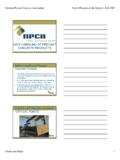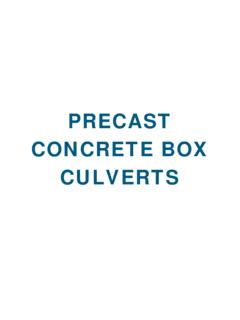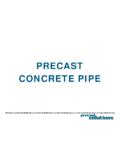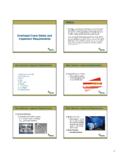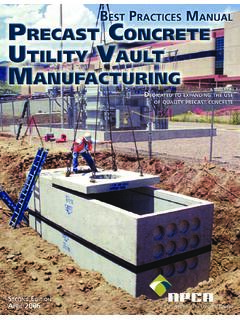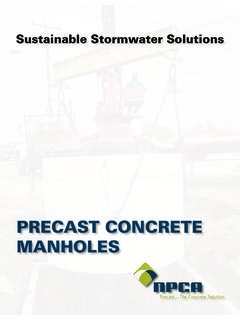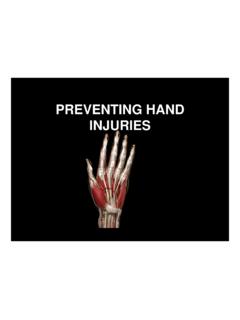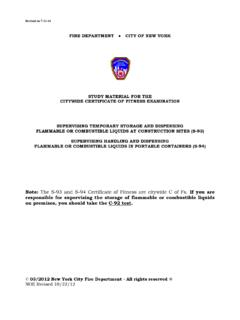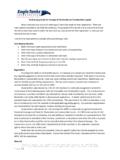Transcription of FLAMMABLE AND COMBUSTIBLE LIQUIDS OSHA Changes
1 FLAMMABLE AND COMBUSTIBLE LIQUIDS n OSHA Changes 2 Introduction n This module covers the two primary hazards associated with FLAMMABLE and COMBUSTIBLE LIQUIDS : explosion and fire. n In order to prevent these hazards, this module and the standard upon which it is based (29 CFR ) address the primary concerns of design and construction, ventilation, ignition sources, and storage. 3 Introduction n The Occupational Safety and Health Administration's (OSHA) Standard - 29 CFR applies to the handling, storage, and use of FLAMMABLE and COMBUSTIBLE LIQUIDS with a flash point below 200 F. n The two primary hazards associated with FLAMMABLE and COMBUSTIBLE LIQUIDS are explosion and fire. 4 Introduction n The primary basis for FLAMMABLE and COMBUSTIBLE LIQUIDS is the National Fire Protection Association's publication NFPA 30, " FLAMMABLE and COMBUSTIBLE LIQUIDS Code." n 29 CFR has changed and widened the definition of FLAMMABLE LIQUIDS to four hazard categories, differing with the standard definition in NFPA 30.
2 FLAMMABLE liquid n FLAMMABLE liquid means any liquid having a flashpoint at or below F (93 C). FLAMMABLE LIQUIDS are divided into four categories as follows: (a)(19) 5 FLAMMABLE liquid Category 1 n Category 1 shall include LIQUIDS having flashpoints below F (23 C) and having a boiling point at or below 95 F (35 C). 6 FLAMMABLE liquid Category 2 n Category 2 shall include LIQUIDS having flashpoints below F (23 C) and having a boiling point above 95 F (35 C). 7 FLAMMABLE liquid Category 3 n Category 3 shall include LIQUIDS having flashpoints at or above F (23 C) and at or below 140 F (60 C). n When a Category 3 liquid with a flashpoint at or above 100 F ( C) is heated for use to within 30 F ( C) of its flashpoint, it shall be handled in accordance with the requirements for a Category 3 liquid with a flashpoint below 100 F ( C).
3 8 FLAMMABLE liquid Category 4 n Category 4 shall include LIQUIDS having flashpoints above 140 F (60 C) and at or below F (93 C). n When a Category 4 FLAMMABLE liquid is heated for use to within 30 F ( C) of its flashpoint, it shall be handled in accordance with the requirements for a Category 3 liquid with a flashpoint at or above 100 F ( C). 9 10 FLAMMABLE Limits n When vapors of a FLAMMABLE or COMBUSTIBLE liquid are mixed with air in the proper proportions in the presence of a source of ignition, rapid combustion or an explosion can occur. n The proper proportion is called the FLAMMABLE range and is also often referred to as the explosive range. n The FLAMMABLE range includes all concentrations of FLAMMABLE vapor or gas in air, in which a flash will occur or a flame will travel if the mixture is ignited. 11 FLAMMABLE Limits n There is a minimum concentration of vapor or gas in air below which propagation of flame does not occur on contact with a source of ignition.
4 N There is also a maximum proportion of vapor in air above which propagation of flame does not occur. n These boundary-line mixtures of vapor with air are known as the lower and upper FLAMMABLE or explosive limits (LEL or UEL) respectively, and they are usually expressed in terms of percentage by volume of vapor in air. 12 FLAMMABLE Limits n In popular jargon, a vapor/air mixture below the FLAMMABLE limit is too "lean" to burn or explode, and a mixture above the upper FLAMMABLE limit is too "rich" to burn or explode. n No attempt is made to differentiate between the terms FLAMMABLE and explosive as applied to the lower and upper limits of flammability. 13 Container and Portable Tank Storage - Introduction n This section applies to FLAMMABLE or COMBUSTIBLE liquid storage in drums or other containers (including FLAMMABLE aerosols) that do not exceed 60 gallons individual capacity.
5 -It also applies to portable tanks with less than 660 gallons capacity. n Portable tanks are closed containers of at least 60 gallons capacity. n The six topic areas covered in this module are listed to the left. "Design, construction, and capacity of containers" - n Only approved containers and portable tanks shall be used. n Metal containers and portable tanks meeting the requirements of and containing products authorized by chapter I, title 49 of the Code of Federal Regulations, shall be deemed to be acceptable. 14 Table H-12 Maximum Allowable Size of Containers and Portable Tanks for FLAMMABLE LIQUIDS Container type Category 1 Category 2 Category 3 Category 4 Glass or approved plastic 1 pt 1 qt 1 gal 1 gal. Metal (other than DOT drums) 1 gal 5 gal 5 gal 5 gal. Safety cans 2 gal 5 gal 5 gal 5 gal. Metal drums (DOT specifications) 60 gal 60 gal 60 gal 60 gal. Approved portable tanks 660 gal 660 gal 660 gal 660 gal.
6 15 Table H-12 Maximum Allowable Size of Containers and Portable Tanks for FLAMMABLE LIQUIDS 16 Container Design, Construction, and Capacity n 29 CFR also requires portable tanks to have provision for emergency venting. n Top-mounted emergency vents must be capable of limiting internal pressure under fire exposure conditions to 10 psig or 30% of the bursting pressure of the tank, whichever is greater. n Portable tanks are also required to have at least one pressure-activated vent with a minimum capacity of 6,000 cubic feet of free air at psia and 60 F. These vents must be set to open at not less than 5 psig. If fusible vents are used, they shall be actuated by elements that operate at a temperature not exceeding 300 F. 17 Container Design, Construction, and Capacity n A portable tank is not intended for fixed installations. n Maximum allowable sizes of various types of containers and portable tanks are specified based on the class of FLAMMABLE and COMBUSTIBLE liquid they contain.
7 18 Storage Cabinet Design, Construction, and Capacity n Regardless of the type of container, no more than 60 gallons of Class I and/or Class II LIQUIDS or no more than 120 gallons of Class III LIQUIDS may be stored in an individual wooden or metal cabinet. n Storage cabinets shall be designed and constructed to limit the internal temperature to not more than 325 F when subjected to a standardized 10-minute fire test. All joints and seams shall remain tight and the door shall remain securely closed during the fire test. Storage cabinets shall be conspicuously labeled, " FLAMMABLE - Keep Fire Away. 19 Storage Cabinet Design, Construction, and Capacity n The top, bottom, sides, and door of metal cabinets shall be at least No. 18 gauge sheet metal and double walled with 1 -inch air space. n The door shall be provided with a three-point lock, and the door sill shall be raised at least 2 inches above the bottom of the cabinet.
8 20 Inside Storage Room Design and Construction n Storage rooms serve the same purpose as storage cabinets, but can be much larger. Inside storage rooms have a variety of requirements which must be followed. n An inside storage room must be designed and constructed so that it complies with the test specifications included in NFPA 251-1969, "Standard Methods of Fire Tests of Building Construction and Materials". 21 Inside Storage Room Design and Construction n The inside storage room must meet requirements for: Construction Wiring Ventilation Rating and capacity Storage. 22 Inside Storage Room Design and Construction n Inside storage rooms must be constructed so that openings to other rooms or buildings shall be provided with non- COMBUSTIBLE , liquid-tight, raised sills or ramps at least 4 inches in height, or the floor in the storage area shall be at least 4 inches below the surrounding floor.
9 They will also be provided with approved self-closing fire doors. n The room shall be liquid-tight where the walls join the floor. 23 Inside Storage Room Design and Construction n A permissible alternative to the sill or ramp is an open-grated trench inside of the room which drains to a safe location. This method may be preferred if there is an extensive need to transfer FLAMMABLE LIQUIDS into and out of the room by means of hand trucks. 24 Inside Storage Room Design and Construction n Electrical wiring and equipment located in inside storage rooms used for Class I LIQUIDS shall be approved under Subpart S, Electrical, for Class I, Division 2 Hazardous Locations. Class II and Class III LIQUIDS shall be approved for general use. n In addition to the wiring requirements there are also very important ventilation requirements. n Every inside storage room shall be provided with either a gravity or a mechanical exhaust ventilation system designed to provide for a complete change of air at least six times per hour.
10 25 Inside Storage Room Design and Construction n Ventilation is vital to the prevention of FLAMMABLE liquid fires and explosions. It is important to ensure that air flow through the system is constant and prevents the accumulation of any FLAMMABLE vapors. n Fire protection systems shall be provided by a sprinkler, water spray, carbon dioxide, or other system. 26 Inside Storage Room Design and Construction n Inside storage rooms shall comply with the following rating and capacity requirements 27 Inside Storage Room Design and Construction n In every inside storage room that is used to store FLAMMABLE and COMBUSTIBLE LIQUIDS , an aisle at least 3 feet wide must be maintained. n Easy movement within the room is necessary in order to reduce the potential for spilling or damaging the containers and to provide both access for fire fighting and a ready escape path for occupants.
